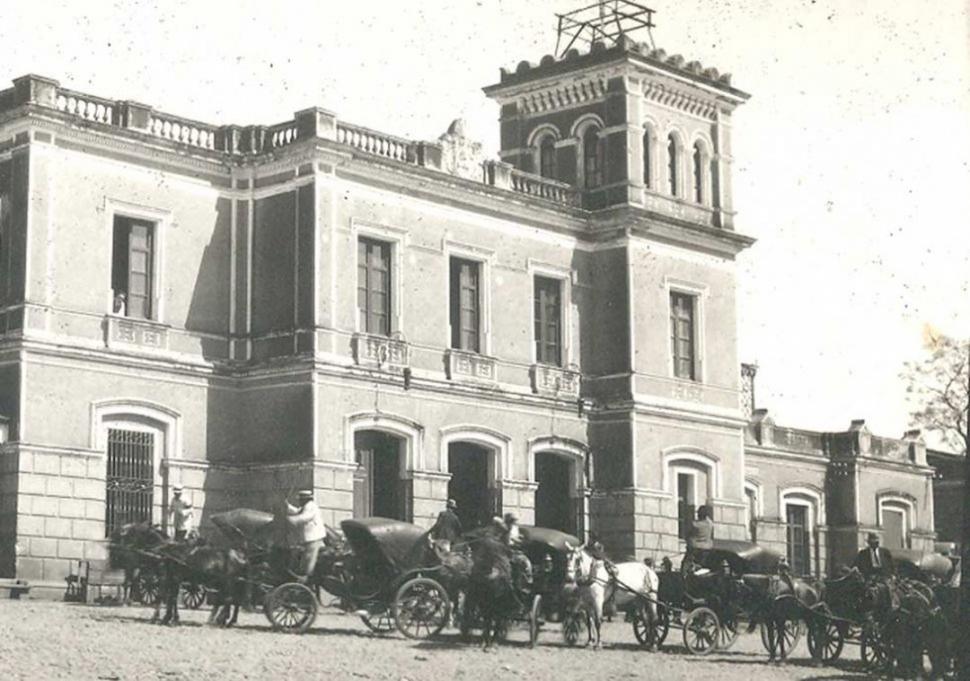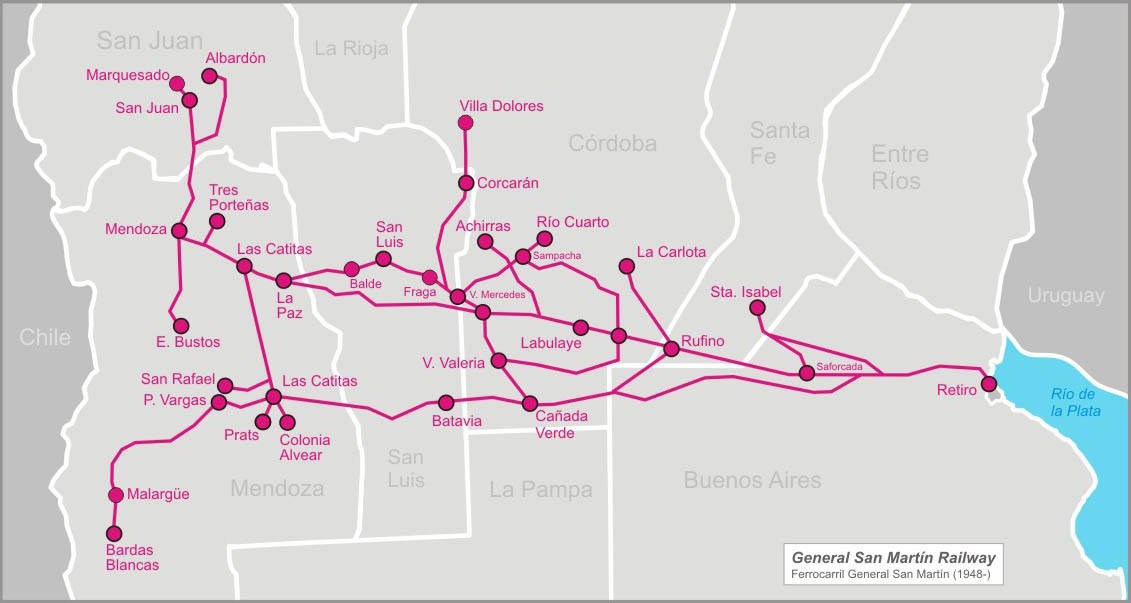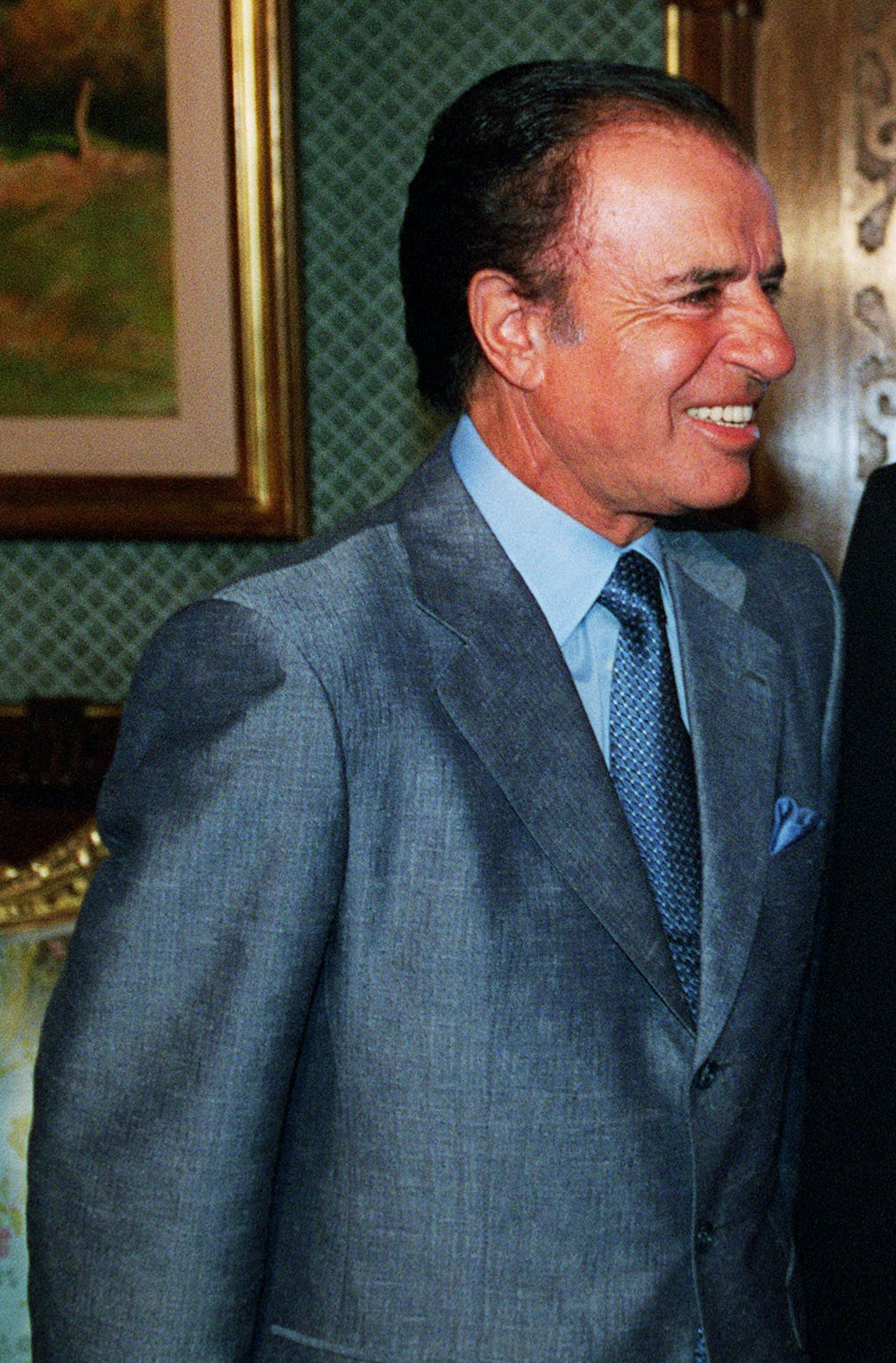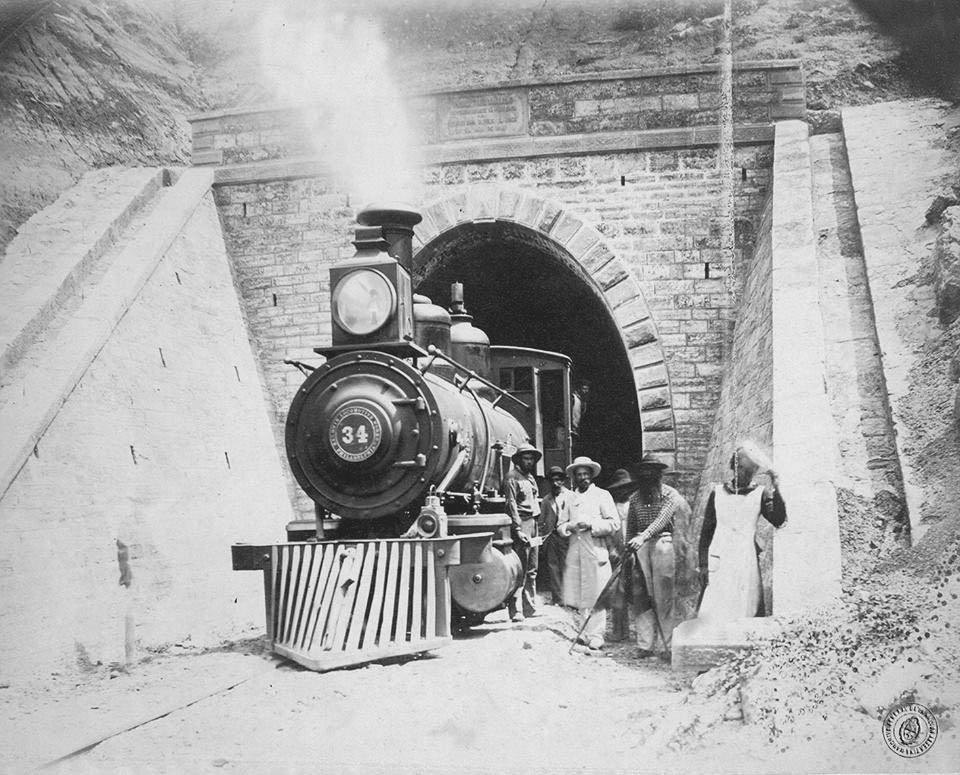|
Tucumán Belgrano Railway Station
Tucumán is a train station in the city of San Miguel de Tucumán of Tucumán Province, Argentina. The station was originally built and operated by the Córdoba Central Railway and then added to Belgrano Railway network. Nowadays the station is only used for freight services, being operated by state-owned company Trenes Argentinos Cargas . History The Córdoba Central Railway was founded in 1887 to take over a concession, originally granted to William Temple in 1885, for the construction of a 206 km line, from the Córdoba city suburb of Alta Córdoba to San Francisco. In October 1887 the Government granted the operation of Ferrocarril Central Norte's 884 km line (that included the Alta Córdoba-Tucumán, Frías-Santiago del Estero and Recreo-Chubicha branches) to Hume Hnos. & Cía (owned by The Hume Brothers) for $ 16,000,000. The Tucumán CC station was the first railway station in the province, placed on the corner of San Martín and Marco Avellaneda streets ... [...More Info...] [...Related Items...] OR: [Wikipedia] [Google] [Baidu] |
Inter-city Rail
Inter-city rail services are express passenger train services that run services that connect cities over longer distances than commuter or regional trains. There is no precise definition of inter-city rail; its meaning may vary from country to country. Most broadly, it can include any rail services that are neither short-distance commuter rail trains within one city area, nor slow regional rail trains calling at all stations and covering local journeys only. Most typically, an inter-city train is an express train with limited stops and comfortable carriages to serve long-distance travel. Inter-city rail sometimes provides international services. This is most prevalent in Europe, due to the close proximity of its 50 countries in a 10,180,000 square kilometre (3,930,000 sq mi) area. Eurostar and EuroCity are examples of this. In many European countries the word "InterCity" or "Inter-City" is an official brand name for a network of regular-interval, relatively long-distance ... [...More Info...] [...Related Items...] OR: [Wikipedia] [Google] [Baidu] |
Railway Nationalisation In Argentina
In 1948, during President Juan Perón's first term of office, the seven British- and three French-owned railway companies then operating in Argentina, were purchased by the state. These companies, together with those that were already state-owned, where grouped, according to their track gauge and locality, into a total of six state-owned companies which later became divisions of the state-owned holding company Ferrocarriles Argentinos. Background In the latter half of the 19th century British and French-owned railway companies had played an important role in the economic development of Argentina. Between 1856 and 1914 the nation's railway network grew to become the largest in Latin America. The foreign investment provided by these companies had helped to transform Argentina from a relatively underdeveloped, rural country, with many isolated communities, into one which was becoming an increasingly prosperous agricultural producer and exporter. The foreign-owned railway compani ... [...More Info...] [...Related Items...] OR: [Wikipedia] [Google] [Baidu] |
Trenes Argentinos Cargas
Belgrano Cargas y Logística S.A., trading as Trenes Argentinos Cargas, is an Argentine State-owned company which operates a freight rail network that includes Belgrano, Urquiza and San Martín railways. It is a subsidiary of Trenes Argentinos. It is often erroneously called Belgrano Cargas by the Argentine government and press, despite the freight network encompassing numerous other Argentine railways, of which the General Belgrano Railway is only one. Overview The network extends through the provinces of Buenos Aires, Santa Fe, Córdoba, Mendoza, Santiago del Estero, San Juan, La Rioja, Catamarca, Tucumán, Chaco, Formosa, Salta and Jujuy. The line also reaches all the Argentina's neighbouring countries, such as Bolivia, Uruguay, Brazil, Chile and Paraguay. TACyL currently operates 122 locomotives and 7,392 goods wagons, employing 3,140 workers whose jobs are guaranteed by the National government. In 2007, its predecessor Belgrano Cargas had transported near ... [...More Info...] [...Related Items...] OR: [Wikipedia] [Google] [Baidu] |
Railway Gazette International
''Railway Gazette International'' is a monthly business magazine and news website covering the railway, metro, light rail and tram industries worldwide. Available by annual subscription, the magazine is read in over 140 countries by transport professionals and decision makers, railway managers, engineers, consultants and suppliers to the rail industry. A mix of technical, commercial and geographical feature articles, plus the regular monthly news pages, cover developments in all aspects of the rail industry, including infrastructure, operations, rolling stock and signalling. History ''Railway Gazette International'' traces its history to May 1835 as ''The Railway Magazine'', when it was founded by Effingham Wilson. The ''Railway Gazette'' title dates from July 1905, created to cover railway commercial and financial affairs. In April 1914 it merged with ''The Railway Times'', which incorporated '' Herapath's Railway Journal'', and in February 1935 it absorbed the ''Railway Engine ... [...More Info...] [...Related Items...] OR: [Wikipedia] [Google] [Baidu] |
General San Martín Railway
The General San Martín Railway (FCGSM) (Spanish: Ferrocarril General San Martín), named after the former Argentine general José de San Martín, was one of the six state-owned Argentine railway companies formed after President Juan Perón's nationalisation of the railway network in 1948. The six companies were managed by Ferrocarriles Argentinos which was later broken up during the process of railway privatisation beginning in 1991 during Carlos Menem's presidency. The FCGSM took over the broad gauge British-owned company Buenos Aires and Pacific Railway. The principal lines departed from Retiro terminus in Buenos Aires to the west through the provinces of Buenos Aires, Santa Fe, Córdoba, Mendoza, San Luis and San Juan. History Background The Buenos Aires and Pacific Railway had been established in London on October 10, 1882, with the purpose to build a railway from Mercedes, Buenos Aires to Villa Mercedes in San Luis Province, where the line joined to Fe ... [...More Info...] [...Related Items...] OR: [Wikipedia] [Google] [Baidu] |
General Urquiza Railway
The General Urquiza Railway (FCGU) (in Spanish: Ferrocarril General Urquiza), named after the Argentine general and politician Justo José de Urquiza, is a standard gauge railway of Argentina which runs approximately northwards from Buenos Aires to Posadas, with several branches in between. It was also one of the six state-owned Argentine railway companies formed after President Juan Perón's nationalisation of the railway network in 1948. The six companies were managed by Ferrocarriles Argentinos which was later broken up during the process of railway privatisation beginning in 1991 during Carlos Menem's presidency. The FCGU incorporated the British-owned Entre Ríos Railway and Argentine North Eastern Railway companies, as well as the standard gauge segments of the Argentine State Railway, and its principal lines departed from Federico Lacroze railway terminus in Buenos Aires to the north east through the provinces of Buenos Aires, Entre Ríos, Corrientes, and Misione ... [...More Info...] [...Related Items...] OR: [Wikipedia] [Google] [Baidu] |
General Belgrano Railway
The General Manuel Belgrano Railway (FCGMB) (Spanish: Ferrocarril General Manuel Belgrano), named after the Argentine politician and military leader Manuel Belgrano, is a railway and the longest of the Argentine system. It was one of the six State-owned Argentine railway companies formed after President Juan Perón's nationalisation of the railway network in 1948. Retiro station is the railway's terminus in Buenos Aires, from which the railway runs to many provinces in the Centre and North of Argentina, such as Santa Fe, Córdoba, Tucumán, La Rioja, Catamarca, Chaco, Santiago del Estero, Salta and Jujuy. In the metropolitan section of the city of Buenos Aires, Ferrocarril Belgrano is divided into two lines, Belgrano Norte and Belgrano Sur, currently operated by Private companies Ferrovías and Argentren respectively. Passenger trains of Norte Line are only run to Villa Rosa in Pilar Partido. From then on, freight services run to the rest of the network, operated by ... [...More Info...] [...Related Items...] OR: [Wikipedia] [Google] [Baidu] |
Belgrano Cargas
Belgrano Cargas S.A. was an Argentine State-owned company which operated the gauge freight rail network built by Central Northern and Province of Santa Fe Railways, which became part of Belgrano Railway network after railway nationalization of 1948. The network operated by Belgrano Cargas extended through the provinces of Buenos Aires, Santa Fe, Córdoba, Mendoza, Santiago del Estero, San Juan, La Rioja, Catamarca, Tucumán, Chaco, Formosa, Salta and Jujuy. The line also reached all the Argentina's neighbouring countries, such as Bolivia, Uruguay, Brazil, Chile and Paraguay. In more recent years, the name ''Belgrano Cargas'' is often erroneously used by the Argentine government and press to refer to the entirety of the country's freight network, and more specifically those parts operated by Belgrano Cargas y Logística. The name has stuck despite the fright network encompassing numerous other Argentine railways, of which the General Belgrano Railway is only one. His ... [...More Info...] [...Related Items...] OR: [Wikipedia] [Google] [Baidu] |
Railway Privatisation In Argentina
Railway privatisation in Argentina was a process which began in 1993 under the presidency of Carlos Menem, following a series of neoliberal economic reforms. This primarily consisted of breaking up the state-owned railway company Ferrocarriles Argentinos (FA) and allowing the former lines to be operated by private companies instead of the state. This policy was met with widespread criticism and proved catastrophic for the Argentine railways whose service worsened significantly in the years that followed, with entire lines closing and infrastructure deteriorating beyond repair. Privatisation was ultimately reversed in 2015 with the creation of Nuevos Ferrocarriles Argentinos. Background Since railway nationalisation in 1948, during the presidency of Juan Perón, the network had been operated by the state-owned company Ferrocarriles Argentinos (FA) which comprised the six relatively independent divisions, Sarmiento, Mitre, Urquiza, San Martín, Belgrano and Roca. By the time ... [...More Info...] [...Related Items...] OR: [Wikipedia] [Google] [Baidu] |
Carlos Menem
Carlos Saúl Menem (2 July 1930 – 14 February 2021) was an Argentine lawyer and politician who served as the President of Argentina from 1989 to 1999. Ideologically, he identified as a Peronist and supported economically liberal policies. He led Argentina as president during the 1990s and implemented a free market liberalization. He served as President of the Justicialist Party for thirteen years (from 1990 to 2001 and again from 2001 to 2003), and his political approach became known as Federal Peronism. Born in Anillaco to a Syrian family, Menem was raised as a Muslim,"Carlos Menem" ''Encyclopædia Britannica'' but later converted to to pursue a political career. Menem b ... [...More Info...] [...Related Items...] OR: [Wikipedia] [Google] [Baidu] |
Central Northern Railway
The Central Northern Railway (Spanish: ''Ferrocarril Central Norte'', FCCN) was the first ( metre gauge) railway built by the Argentine State Railway. Its aim was to extend the existing British-owned Central Argentine broad gauge) railway from Córdoba to Tucuman and metre gauge was chosen for economic reasons. History Origins A Law promulgated in October 1868 destinated money collected from foreign trade and import taxes to the construction of a railway line between the Provinces of Córdoba and Jujuy. The construction and subsequent operation of the line was entrusted to "Compañía Telfner", who began to work on the line in 1873, reaching the city of Recreo ( Catamarca) on 1 May 1875, San Antonio, Jujuy in July that same year and finally reaching San Miguel de Tucumán on 30 October 1876, being formally inaugurated by then President of Argentina, Nicolás Avellaneda. On 28 December 1876 the national government took over the running of the line and appointed Rafaé ... [...More Info...] [...Related Items...] OR: [Wikipedia] [Google] [Baidu] |









